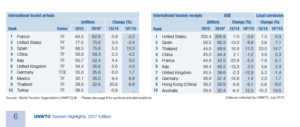Japan is enjoying very healthy growth of inbound tourism.The number of inbound tourists, which stood only at 8.36 million in 2012, set record highs for the sixth year in a row. It continues to thrive as a record 28.7 million tourists visited Japan in 2017, up 19 % from the previous year. In 2016, it was up 21 % and in 2015, up 47 %.
Visitors from China, South Korea, Taiwan and Hong Kong account for more than 70 % of the total number.
The number of Chinese travelers grew 15% to 7.35 million, South Korea increased 40 % to 7.14 million.
2018 January number will be announced on February 16 but apparently it is keeping the nation on track for the government’s target of boosting the annual number of visitors to 40 million in 2020.
There are some challenges, however, that must be overcome, such as a tight supply of accommodations that cater to overseas guests and a heavy concentration of visitors from East Asia.
Further efforts should be made to realize the full potential of inbound tourism as one of the nation’s key growth industries including welcoming more American and European visitors
who have a tendency to stay longer with bigger spending budgets.
(Chinese tourists spend less than Europeans and Americans on accommodations and foods)
Japanese people are regularly talking about the latest inbound tourism booming but how does the industry look more in the global perspective ?
Is only Japan performing well ?
In order to analyze the Japan in the global market, let’s look at the 2017 report published by UNWTO (UN World Tourism Organization).
Overall, International tourist arrivals in 2016 grew by 3.9%
to reach a total of 1,235 million worldwide, an increase of 46 million
over the previous year. It was the seventh consecutive year of above
average growth in international tourism.
In another words, Japan as well as other destinations are having a good time in the past few years.
Japan’ s growth of over 19% is well above the world growth average (3.9%) and it is fair to say that Japan’s performance is robust.
According to the UNWTO, international tourist arrivals in Europe reached 671 million in 2017, a remarkable 8% increase.
Asia and the Pacific (+6%) recorded 324 million international tourist arrivals in 2017.
Arrivals in South Asia grew 10%, in South-East Asia 8% and in Oceania 7%. Arrivals to North-East Asia increased by 3%.
The Americas (+3%) welcomed 207 million international tourist arrivals in 2017, with most destinations enjoying positive results.
Asia and the Pacific recorded 308 million international tourist arrivals in 2016, an increase of 9%, or 24 million more than in 2015, the highest increase in both relative and absolute terms across the UNWTO regions.
Asia and the Pacific accounted for 25% of the world’s arrivals and 30% of the world’s receipts (expenditure by international visitors on accommodation, food and drink, entertainment, shopping and other goods and services),
All four subregions enjoyed strong results in 2016. Growing purchasing power in emerging economy markets, increased air connectivity, more affordable travel and a relaxation of visa requirements continue to fuel tourism demand from within and outside the region.
In terms of arrivals, the Republic of Korea (+30%) rebounded strongly after the MERS outbreak in 2015 and Japan (+22%) boasted its fifth straight year of double-digit growth.
In terms of the receipt (expenditure by international visitors on accommodation, food and drink, entertainment, shopping and other goods and services),
France, the United States, Spain and China continued to top the
international arrivals ranking in 2016. In receipts, the US and Spain
remain at the top, followed by Thailand, which climbed to number
3 last year, and China, which is fourth. France and Italy moved up in
receipts to 5th and 6th position respectively, while the United Kingdom,
Mexico and Thailand moved up to 6th, 8th and 9th place in arrivals.
Notably, Thailand climbed up the position from 5th to 3rd.
The amount of worldwide receipt in tourism destinations reached US$ 1,220 billion (euro 1,102 billion) in 2016, up 2.6 % from previous year.We, real estate investors, should pay close attention to this transition — because it’ll probably happen fast.
China will continue to lead the outbound tourism in
the regions in the future, and also will top the expenditure
ranking.
According to an article in Business week, only 5 percent of Chinese have passports. As that number grows, China’s tech companies will have more opportunities to cater to them. In doing so, they’ll start acquiring the know-how needed to expand more aggressively into foreign markets including Japan.
In fact, it is evident that more international travelers tend to go to the destinations close to their regions.
Japan’s close location to China is a big advantage.
Those Chinese travelers will give the significant impact
on the Japanese real estate industry as well.
Savvy Chinese companies are not missing the opportunities.
For example, Chinese vacation rental company, Tujia.com, a rival to Airbnb Inc., is expanding in Japan by targeting properties owned by Chinese and local investors.
The existing city hotels in Tokyo and Osaka are recently reported to
experience unusually high booking rate (around 75-85%)
due to the massive growth of foreign tourists and room availability is still very tight.
Big corporations such as Nomura and Daiwa House already announced the plan to launch
their new hotels.
Considering the tight accommodation and robust increase of the inbound tourists,
there are good opportunities to invest in the boutique type of hotels and vacation rental by converting the empty houses into
the hotels to accommodate the big family nationals such as Chinese and Thais.
The world ranking of the destinations (image from 2017 UNWTO report)

(Please click to enlarge the image.)
The link to UNWTO tourism highlights 2017 below.
Toshihiko Yamamoto
Real estate investing consultant and author.
Toshihiko is currently writing a book about the real estate investing in Japan
for foreign investors.
Founder of Yamamoto Property Advisory in Tokyo.
International property Investment consultant and licensed
real estate broker (Japan).
He serves the foreign companies and individuals to buy and sell
the real estates in Japan as well as own homes.
He holds a Bachelor’s degree in Economics from
Osaka Prefecture University in Japan
and a MBA from Bond University in Australia

